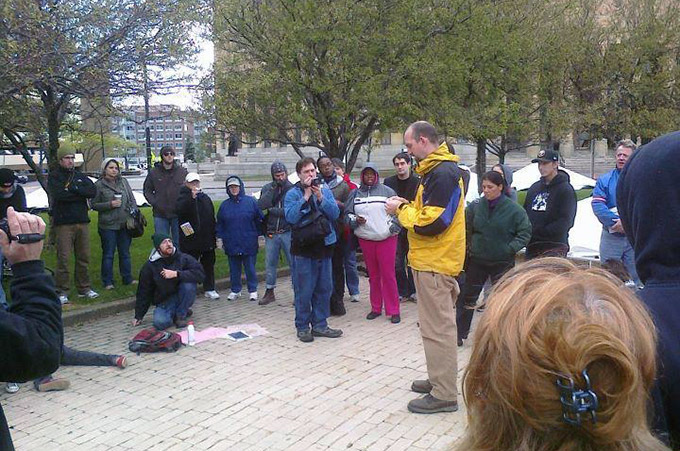Next story: The Check Was in the Mail
Occupy Buffalo
by Peter Scheck

About 90 people stood in a cold breeze in Niagara Square last Saturday in group that had been promoted on Facebook as the first meeting of “Occupy Buffalo.” No one held signs or shouted. This didn’t seem designed to be a protest. The only witnesses, besides a crew setting up tents for a wedding, were the occasional drivers on the south side of the circle. A few sounded their horns, but the honks were mostly ignored. Those assembled were a diverse group of ages and cultures, with a long list of social, environmental, and economic issues. One by one, upon arriving, they introduced themselves and the reason they came out to the event.
The meeting was in response to New York City protests which have been growing in size and spreading to other cities since they began September 17. Several hundred protesters calling themselves Occupy Wall Street have been living in a park in downtown Manhattan to raise awareness of what they see as the greed and misconduct perpetrated by corporations, banks, and insurance companies. Their slogan refers to the people as “the 99 percent.” The group’s profile was raised last weekend, when the New York Times reported that nearly 700 people were arrested marching over the Brooklyn Bridge.
Occupy Buffalo is a pluralist group of citizens with a wide gamut of grievances. Retired General Motors workers spoke about free trade and losing American jobs overseas. Business owners told of their frustrations with high taxes. Young people spoke of campaign finance reform and ending corporate personhood. Students bemoaned the price of public higher education An ex-postal employee decried the downsizing of the postal service. The group’s viewpoints few the gamut from liberal to libertarian, from clean air to clean government.
A man named Henry had drawn a flowchart on a piece of cardboard which detailed a consensus-based decision making process. (Discussion leads to a proposal, a proposal is voted on by show of hands, the concerns of dissenters are heard, after which a consensus can be reached.) This, along with being the self-proclaimed “guy who set up the Facebook page,” seemed to be enough for the group to make him the group’s facilitator.
What began as a group of about 40 people introducing themselves grew to a swollen circle of about 90 speaking enthusiastically about the coming weeks of activities. Would they attempt to occupy Niagara Square? It will get cold. Would they become violent? Possibly. Will they fight back? If necessary. If the Wall Street protests, which came up frequently in the discussion, served as the precedent for what is possible in Buffalo, many have cited the revolutions in Tunisia and Egypt as the influence of the occupy movement.
Occupy Wall Street has taken criticism for failing to have a concise goal. Likewise, when it was submitted that the Buffalo group move to oppose corporate personhood, the group voiced their disapproval. It was too early for the group to make demands, they said, like a jury heading back to the deliberation room. We are used to crowds behind barricades when politicians come to speak, the religious right holding signs outside the clinic, the anti-war folks wearing black outside the farmers market on Saturday mornings. This new process seems influenced not by an event or a person but by a uniform feeling of powerlessness. They are eager to organize together against a shared feeling of inequality, before ironing out the specifics. Meet now, make signs later.
Occupy Buffalo, despite a near coup between two opposing Facebook groups, comes off as sharply organized, astute, and practical. About halfway through the event, the group adopted a new method of showing support for an idea. Instead of applause, they silently put their hands up and wiggled their fingers. This is an idea used in the Wall Street protest’s daily assemblies, where there is no amplified sound. When an individual speaks, his words are repeated sentence by sentence in unison by everyone within earshot. The finger-wiggling (conversely keeping the hands low or keeping them level for uncertainty) helps ensure everyone can be heard by the group. The protests in New York City have been successful in attracting big names like Michael Moore and Cornel West, and their numbers seem to be always growing. This is a part of the reality of protests: Attention begets attention.
The Occupy movement is an opportunity for regular people to have their voices heard. In light of our stripped and dirty libraries, gutted social services, and financially abandoned arts organizations, we could have used action like this a year ago. Perhaps this gathering will serve as a reminder of the strength of numbers.
The next meeting will take place in Niagara Square this Saturday, October 8, at noon.
—peter scheck
blog comments powered by Disqus|
Issue Navigation> Issue Index > v10n40 (Week of Thursday, October 6) > Week in Review > Occupy Buffalo This Week's Issue • Artvoice Daily • Artvoice TV • Events Calendar • Classifieds |









 Current Issue
Current Issue